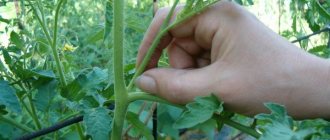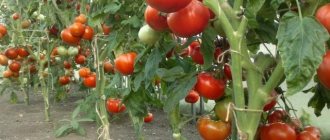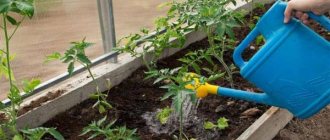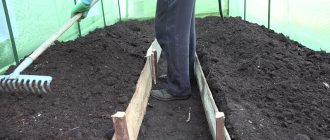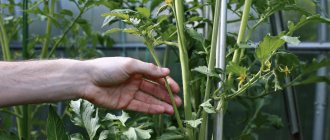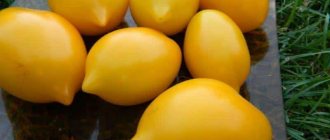Why are tomatoes tied up?
Tying up tomato bushes is carried out in order to prevent the stem from breaking due to the heavy fruits that form on the plant. If you do not tie it up, then after the fruits form and grow, the stem will bend and, if it does not break, it will begin to creep along the ground. In such a situation, plants are easily damaged by slugs and other ground-based pests, as well as fungal diseases.
Benefits of proper garter
The following are the benefits that a gardener receives from tying up bushes:
- easier to care for plants;
- when watering there is no risk of water getting on the surface of the leaves, which prevents rotting of the bushes;
- it is much more convenient to form and carry out pinching on tied bushes;
- upright bushes receive more light, which helps the fruits ripen faster;
- free access of air reduces the risk of fungal diseases, in particular late blight.
Further care
After tying the plants should be watered
The tied tomatoes should be watered immediately after the procedure. Further care is not much different from the classic one.
Microclimate
Creating a favorable climate in a polycarbonate greenhouse involves:
- temperature regime at 25 – 28°C during the day and not lower than 18°C at night;
- the humidity level is no more than 55%, for which ventilation is regularly arranged;
- tied bushes are watered by the root method, if possible, drip irrigation is installed;
- during the hot season, watering is carried out at intervals of 2-3 days, and when vegetables ripen - once every 6-7 days;
- After moistening, the soil is loosened, creating freedom for oxygen to penetrate into the ground.
Stepsoning
Tomatoes in a greenhouse require pinching. Ignoring this procedure weakens the plant, negatively affecting the amount of harvest.
Wherein:
- a tall bush is usually formed into 1 stem, removing all side shoots and pinching the central crown as soon as the 7th fruiting cluster is formed;
- for medium-sized varieties, 2-3 stems are often left.
The stepsons are broken out manually, because a mechanical procedure, unlike pruning with a garden tool, is less traumatic for the plant.
Pollination
Greenhouse conditions create obstacles to the natural pollination of tomato bushes, therefore, when growing tomatoes in a closed structure, it is recommended to open the transoms more often during the flowering stage and create drafts, leading to the movement of pollen throughout the greenhouse along with wind currents.
It is permissible to carry out additional pollination manually, shaking flower-bearing brushes, collecting and applying pollen with a toothbrush or cotton swab.
Feeding
Tomatoes are fed with potassium and phosphorus, giving preference to foliar spraying on the foliage. At the fruiting stage, fertilizers (chicken manure, superphosphate) are best applied at the root.
Treatment against diseases and pests
Tomatoes growing in a greenhouse are less susceptible to attack by pests, and tying them up ensures free circulation of air flow, preventing the occurrence of rot and other infections. But still, you should not neglect treatments against insects and diseases. You just need to reduce their number by half.
For treatments, you should also not use concentrated products, without which you cannot cope when growing tomatoes in an open garden bed.
For healthy greenhouse tomatoes, preventive treatments with folk remedies (for example, garlic infusions) or biological preparations (for example, phytosporin) are often sufficient.
How to tie up tomatoes. “Free loop” method. (06.06.16)
How to quickly tie up tall tomatoes in a greenhouse.
Garter of tomatoes (tomato) in a greenhouse
When to tie up tomatoes
The first garter for tall varieties is done 3-5 days after planting the seedlings. In the future, this event is carried out regularly as the bushes grow. Although some gardeners recommend that the first tying be carried out only after the seedlings have taken root well and form 2-3 new leaves in a permanent place of growth.
What to do before gartering
Before starting to garter the bushes, the tomatoes are pinched. This event increases crop productivity. If you do not remove the side shoots that form in the axils of the leaves, then you may not wait for fruiting, since the plant will begin to form only stems with flowers.
Reference. Stepchildren are carried out once every 10-12 days, not allowing the stepsons to grow more than 5 cm.
Decide in advance on the method of tying the bushes, prepare all the materials necessary for this. If fabric, elastic bands or other garter devices are used for a second season, they must first be washed and disinfected.
Do I need to tie it up and when should I do it?
Tied tomatoes in a greenhouse
Gardeners who have been breeding and growing tomatoes for many years know that it is imperative to tie up the stems. This is due to the structural features of the plant, as well as its susceptibility to various pests and diseases.
The reasons for the importance of the garter are:
- thin and fragile stems (if they are not tied up, heavy fruits will pull them to the ground, which, in turn, will lead to the breaking off and death of the plant);
- susceptibility to diseases (if preventive garter is ignored, the fruits fall to the ground, and there they can be damaged by various harmful insects or diseases characteristic of a given crop);
- convenience of watering (agronomists and experienced gardeners know that tomatoes need to be watered at the root; the leaves do not like excess moisture; when the plant is tied up, it is easy to water it without affecting the leaf contents, since it is located at the top).
These factors prove that preventive gartering, done correctly, will help keep the crop intact and make it easier for the gardener to care for the cultivated plant. It is better to do this on time and not worry about your harvest, than to spend a lot of time and money on growing and then lose the entire tomato harvest.
In addition, there will be much more space in the greenhouse. Tied tomatoes do not take up much space. You can easily carry out agricultural cultivation without fear of getting entangled in a jungle of intertwined stems. Also, tied plants are less susceptible to various diseases.
Tomato bush garter
In general, tying is carried out at the moment when the plant is already quite tall and has at least 8 - 10 formed leaves. In addition, there are certain general rules for gartering, based on the varieties of tomatoes. In particular:
- 35–40 days after planting – early ripening varieties;
- for 50 – 60 days – for mid-ripening tomatoes;
- on 70 – 80 days – for late-ripening varieties.
The gardener must himself assess the size of the grown plants and decide whether they need a garter or whether free cultivation can continue for now. There are quite a few ways of tying, so each plant can have its own separate support, and tomatoes can also be tied to a common pipe, horizontally or vertically. The choice of method directly depends on the tomato variety and its characteristics.
Devices and materials for garters
To securely fix the plants, supports and garter material are used. Long wooden stakes or metal rods are used as supports. As for the material for tying, soft fabric or elastic but durable material is suitable.
There is a special device for gartering, which in appearance resembles a combination of garden pruning shears and a stapler, which is equipped with adhesive tape and a cutter. Using such a device, it is much easier to fix the branches of a tomato bush to a support. The plant is not injured in this case.
A simple and inexpensive option is plastic clips that fasten with one click . The devices are reliable and can withstand any weight. They can be used for many years in a row. For fixing plants, you can select clips of a suitable size for stems and branches with fruits.
Reference. You cannot use thin thread, fishing line or other hard materials to secure the stems of the plant, as they can injure the stem or even break it.
What gardeners advise
Gardeners advise:
- start tying up plants at the first signs of the stem leaning towards the ground, avoiding its deformation;
- Whenever possible, use only natural materials as support and garter and do not use synthetics and plastic that do not allow air to pass through;
- install supports on the north side of the bushes, without interfering with sunlight;
- As the plant grows, regularly move the garter material or replace it with a new one;
- Do not attach the stem in the form of the number “8”, because there is a risk of squeezing it, which will disrupt normal development;
- at the fruiting stage, tie up the brushes along with the branches, which will provide additional protection for preserving the harvest;
- leave a distance of 1 to 2 cm between the stem and the support, which will allow the shoot to thicken.
Effective ways to tie tomatoes
When choosing a method for tying bushes, focus on the characteristics of a particular variety, the weight of the fruit, and the height of the bush. It is necessary to decide on the scheme and type of attachment of plants to the support even before planting the seedlings.
The easiest way to tie tomatoes is with stakes.
Simple stakes are used as support, which are installed near the plants. The height of the support approximately corresponds to the height of an adult plant.
This method is suitable for tomato varieties with medium-sized fruits and for bushes of medium height. Tall or heavy plants may fall along with the installed support to which they are tied.
Wire hook method
One of the most ancient methods. The author of this technology is I. Maslov. To create structures, you will need a strong thread or fishing line, on which small loops are made at intervals of 15-20 cm. This fishing line is attached to the ceiling of the greenhouse near each bush.
Using wire hooks or open paper clips and rubber bands, attach the tomato stems to the looped fishing line. They grab it with an elastic band under the branch of the bush and hook it to the nearest loop.
The convenience of this method is that as the plant grows, it is enough to simply add new hooks and secure the stem. This design is capable of holding even the heaviest bunches. Due to the elasticity of the elastic band, they will lean slightly toward the ground, but will not fall or break.
Horizontal garter method
Horizontal fastening (on a trellis) is used for tall plant varieties. Install strong metal posts along the edges of the greenhouse, after which the rope is pulled, maintaining an interval of 30 cm. The structure should look like a strong mesh.
Plastic clips are used to attach to the trellis or all plants are threaded through a rope mesh. You can replace the rope structure with ready-made trellises made of wooden or plastic material (slats).
Reference. When constructing a trellis, it is important to take care of its reliability so that it does not fall under the weight of the fruit.
Using a Grid
A metal or plastic mesh is used as a support, which is attached between the posts of the greenhouse frame. The most convenient to use is considered to be a coarse mesh. On it you can place the stems and branches of plant bushes in accordance with the direction of their growth.
As the plant develops, you can change the place of tying and secure it at a different, more convenient level.
SUPER WAY FOR TIING TOMATOES! Easy and fast!!!
Arranging a trellis - for tall varieties of tomatoes
Another type of trellis is vertical, in which plants are tied to the roof of the greenhouse. To do this, use a rope, one end of which is fixed to the ceiling of the greenhouse, and the other to the stem of a tall tomato bush. Using this method, you can tie up even the heaviest bunches of plants without fear that the support will break or fall.
Reference. To prevent injury to the branches and stems of bushes, the support rope should be chosen wide, soft and durable.
The use of bush holders when growing tomatoes
The use of bush holders, or in other words, a wire frame, is suitable for varieties that form compact bushes with a large number of fruits.
The design uses a mesh with large cells, which is wrapped around the plants in the shape of a cylinder and dug into the ground. With the help of a bush holder you can secure both the main stem and heavy branches with large fruits.
At any time, the device can be dug up and moved to another site. The only disadvantage of this tying method is the difficulty of harvesting.
Instructions on how to tie up tomatoes: the best ideas for fastenings and devices for a greenhouse
Reading time: 6 minute(s) Almost all experienced gardeners have switched to growing vegetables in greenhouses. This helps preserve crops even in the most severe frosts, in all weather conditions. Typically, the greenhouse frame is quite strong and durable, and the required optimal air temperature and humidity are always maintained inside.
The most popular vegetables grown on private plots are tomatoes. The use of this vegetable is widespread in every corner of our country. It is perfect for preparing a variety of dishes, as well as canning for the winter. Caring for this crop is usually not difficult and includes proper watering and tying up. But as for how to tie up tomatoes in a greenhouse, there are several important nuances. Let's take a closer look at them.
Tying tomatoes: what is it for and why?
Many gardeners wonder why they need to tie up tomatoes and whether it’s worth doing it at all. In order to answer these questions, you need to study the rules for caring for tomatoes and the requirements, following which, you can get a good harvest.
Due to the fact that this vegetable does not have a very strong stem, it can bend under the weight of the fruit, and in some cases even break.
Therefore, the tying procedure is carried out so that the stem is preserved and can support the tomatoes.
If you do not do this and it breaks, this will immediately lead to the death of the plant. If the stem begins to bend under the weight of the fruits, they will end up on the ground. This leaves them susceptible to many diseases and pests such as slugs. They damage the fruits, which then become unfit for consumption. Another important criterion why we tie up tomatoes in a greenhouse is the convenience of watering.
This means that when they are tied up, their foliage is high above the ground. When watering plants, the liquid gets only onto the stem and root system, without affecting its other components.
Gardeners who have been growing tomatoes in their greenhouses for many years know that water getting on the leaves has a negative impact in the future.
This leads to the fact that initially they begin to dry out, then wither and in some cases this all leads to the death of the entire plant.
Benefits of proper tying
Proper tying will allow your plant to develop well and quickly. Prevents it from being damaged by various pests and diseases.
This has a positive effect on the quality of your vegetables. Helps you to carry out proper watering, and this in turn preserves the plant and its fruits. Also, after tying up, your beds will look more well-groomed and tidy.
But there will be more space on the site, since when tied up, the tomatoes will not occupy much territory.
Adaptations
There are many devices with which you can tie up tomatoes in greenhouses.
They are varied, differing in the material from which they are made and the way they are placed in the greenhouse.
These include:
- Leg-split.
- A loop.
- Clothespins.
- Rods.
Each of these devices is unique in its own way and each gardener can choose what he likes. But before you make your choice, you need to understand what each of them is.
- Twine for tomato garter
- A loop
- Clothespins
- Rods
In this case, we will need pegs and twine, which can be used as pieces of fabric. It is best to take durable materials that do not stretch, so it will be better to carry out the procedure.
Prepare the pegs in advance; their height should be about 1.5 meters, so that they are 30 - 35 centimeters higher than the bush.
This is done so that the bushes can develop further along the peg. Then decide on their location; it will be suitable to place one near each bush.
This will be the best option for both you and your vegetable.
Place the peg in the ground to a depth of about 15 - 20 centimeters, this is necessary so that it holds firmly and can withstand the weight of the fruit.
Then carefully take the bush, lift it and tie it to the base using scraps of fabric of any length and width.
This is the easiest way of tying, it will not take much effort and time, but at the same time it will help you and your plant well.
To perform tying in this way, you will need fabric or rope, as well as pegs. In this case, just as in the previous one, the peg should be about 1.5 meters long and go 20 - 25 centimeters into the soil.
In order to firmly anchor itself in the ground. A loop is made from rope or fabric into which the plant stem is threaded, and the free ends of the rope are secured to a peg.
Please note that you should not make knots, but rather simply wrap the rope around it.
This is because you will have to re-tie your plant almost every week as it grows.
In this case, you will need a peg and a special clothespin for tying. It can be purchased at any gardening store for little money.
Using this object, a stem of a bush with tomatoes is attached to a stake driven into the ground. This helps maintain the aesthetic appearance of your beds and supports the vegetable.
You can make a so-called cage near each bush. It can be made from wire or any other available materials. And on top of this structure, make circles from rods and place them in the middle. Tie tomatoes to them; they will grow upward along the rods.
There is also a way to tie several rods, their number depends on the number of tomato bushes. These rods are connected at the top with wire. This helps save space on your site and give it a neater look.
Best ideas
Step-by-step tying to an individual support:
- Place the peg in the ground to a depth of approximately 20 centimeters.
- Carefully lift the tomato bush and give it the desired position.
- Using the necessary item, tie up the bush.
Wire frame mounting:
It is carried out using a metal mesh, which is inserted into the ground. You need to wrap it around the plant and thus it will grow up it.
Linear mount:
This type can be used for several seasons in a row. A rope or wire is pulled over each row of tomatoes slightly below the level of the upper branches. Then the plants will be attached to this stretched rope using a garter.
Trellis fastening:
To do this, you need to place two strong metal poles at both ends of the greenhouse. Draw ropes from them, between which there will be a distance of about 30 - 35 centimeters. Thus, something similar to a grid is created; bushes need to be attached to it. Vertical trellis
Ropes are attached to the ceiling of the greenhouse and lowered to the plants. Using a small peg tied to the other end of the rope, it is attached to the soil. Thus, the plant will grow upward along the rope.
Mesh mount:
Metal poles are placed at both ends of the greenhouse, and a mesh with large holes is stretched over them. The stem of the plant is threaded through them, so it branches upward.
Tying up tall plants
This is done by using a net, as this allows you to regulate the necessary plant growth and it is possible to grow even very tall plants.
Low growing varieties
For these types of tomatoes, using a loop or trellis is optimal. There is no need to add a net to this, since it is intended for taller plant varieties.
Medium sized tomatoes
For such varieties, using any tying option is perfect; they will grow comfortably in any case.
Review of materials
It is best to use materials such as metal mesh or tying with rods. This will provide the most comfortable conditions for the plant, and they will be able to grow and develop.
How to avoid mistakes: advice from agronomists and summer residents
Experienced summer residents advise starting tying tomatoes when they reach a size of about 30 - 35 centimeters, that is, they are already relatively mature.
This is due to the fact that it will be more comfortable to tie them up this way. And at this time, the stem of the plant is more elastic and can be bent, but this will no longer be possible.
Since over time the stem becomes stronger and attempts to give it the position you need end with it breaking. And this leads to the plant dying and withering.
With proper garter, any variety of tomato will grow better and produce a good harvest. It is necessary to take into account the specifics of the material used, the height of the future plant and many other nuances. Otherwise, greenhouse plants run the risk of not developing and, as a result, not producing proper fruit.
Did this article help you? We would be grateful for your rating:
19 2
Special recommendations for tying tomatoes in a polycarbonate greenhouse
What is the best way to tie tomatoes in a polycarbonate greenhouse?
Despite the fact that the trellis fastening method is considered the most labor-intensive and complex, it is recommended to use it in polycarbonate greenhouses. Polycarbonate is characterized by good light transmission and quickly accumulates heat.
The maximum amount of light is provided to the plants and “heat stroke” is prevented by allowing the branches to be arranged evenly and spaciously on the trellis.
Features of tying different varieties
The choice of garter method depends on the growth of the tomato bush.
To properly tie tomatoes in a greenhouse, you need to choose the right method. And to do this, you initially need to have an idea of the height of the tomato bushes. Some methods are good for tall bushes, while others are suitable exclusively for low-growing tomato varieties.
Agronomists give the following advice on choosing a fastening method:
- low-growing varieties (small tomato bushes can be secured using trellises or a loose loop; other tying methods are not very suitable for small bushes);
- medium height (these are universal varieties that are suitable for any conditions of maintenance and tying; they will grow and develop well with any of the presented tying methods);
- tall bushes (the best solution would be to use a mesh or frame round fence for each bush; with the help of such fastening the plant can grow large and strong).
The best materials are metal mesh or rods. These are good options for tomato plants. With such methods, they develop well and are not subject to deformation under the weight of their own fruits.
Are the methods of gartering different in open ground?
If low-growing varieties are grown in open ground, then in many cases there is no need to tie up the plants . However, if the bushes produce a large number of fruits that are heavy in weight, then the stems and branches of the plant will still have to be fixed.
To do this, choose any of the above methods of tying in a greenhouse. But not all of them are convenient to use in open ground conditions. The trellis method, both horizontal and vertical, will be very problematic to apply in a garden bed.
Gardeners use the simplest method with stakes or construct bush holders. When tying tomatoes in open ground, choose a reliable structure, since strong winds can knock down the support and the plant. When constructing a cylinder of mesh with large cells around each tomato bush, it is recommended to dig it a little deeper than in a greenhouse. This will give the structure reliability and stability.
Despite the fact that constructing a wire frame for each plant is costly and time-consuming, and it will be more difficult to collect fruits from the bushes, it should be preferred if there are frequent, strong and gusty winds in the region where the crop is grown.
Why is tomato garter used in greenhouses and open ground ↑
Not all varieties of tomatoes can be tied up. It is mainly needed by tall bushes that bend to the soil under the excessive weight of the fruit. Tomato gartering is not carried out on large areas in open ground, because low-growing, early-ripening varieties are planted there, which quietly develop without support.
Industrial cultivation of tomatoes in a greenhouse
However, mainly tall varieties are cultivated in greenhouses, and they are characterized by abundant fruiting. The use of such varieties is more feasible from an economic point of view. This makes it possible to obtain the maximum amount of fruit from a small greenhouse area.
For your information! Some gardeners believe that tomatoes, especially in open ground, do not need to be tied up, since the plant should take root further along the stem and develop naturally without human intervention, receiving additional substances from the soil.
Growing tomatoes on a horizontal trellis
But creating greenhouses and growing plants in them is in itself an intervention in the normal course of events, so you need to guide the process from beginning to end. Let's take a closer look at the main advantages of gartering tomatoes in a greenhouse. And let each owner decide in the future whether it is necessary to tie up tomatoes on their site.
- The appearance of stepsons contributes to the growth of the bush, but the fruits growing on them rarely have time to ripen. The stepson takes away a lot of nutrients from the bush, which negatively affects the quality and size of the fruit. It is much more convenient to carry out the pinching procedure on a tied tomato bush. This will allow you not to bend over too much and look for stepsons on the intertwining stems to remove.
- Fruits located on the ground ripen unevenly. The side on which the fruit comes into contact with the ground will ripen slowly, giving the vegetable an unmarketable appearance. Rot often forms there.
- Tiled tomatoes are easier to care for. When watering, splashes of water mixed with the soil fall not only on the ovaries and leaves (which tomatoes do not like), but also contaminate the fruits. Tethered plants are easier to water at the root.
- Tied tall plants can easily withstand the weight of bunches of fruit and not break.
Tomatoes without garter - As you can see in the photo, gartering a tomato is still necessary. If tomatoes lie on the ground, they will be attacked by slugs and other pests. More dangerous is infection with late blight, the causative agent of which comes from the soil.
- When the bush is positioned vertically, a significant part of the greenhouse area is saved and a larger number of bushes can be placed per 1 m².
Excellent tomato harvest in a polycarbonate greenhouse
It turns out that without a garter, a tomato can simply lose its harvest. In this case, a well-developed root system and proper care of the plant will not help. In addition, it will be much more convenient for greenhouse owners to collect ripe fruits on tied tomatoes rather than look for them on the ground.
Secrets of experienced gardeners for gartering tomatoes
When starting to plant tomatoes, study the recommendations of experienced gardeners:
- you should not tie the stems to the supports using a figure eight knot, as this increases the risk of damaging the plants;
- tie up not only the main stem, but also individual branches with bunches of tomatoes - this will protect them from falling to the ground;
- use staking only when growing medium-sized crop varieties;
- It is better to attach tall tomatoes to a trellis;
- To prevent the occurrence of late blight and other fungal diseases, fruits should not be allowed to come into contact with each other or with the soil.
General rules for gartering tomatoes in a greenhouse
Tomatoes are tied at the initial stage of bush development, when the shoots are still flexible and the risk of damage is minimized. The general rules for gartering tomatoes apply to all plants, regardless of how they are grown:
- The material used should be used once; at the end of the season, the garters are discarded.
- The type of supports is selected depending on the specific variety of tomatoes.
- Parts of the supporting structure must be disinfected with a saturated solution of potassium permanganate.
- Before gartering, the tomatoes are first planted.
- The twine used should not tie the stem close to the support; it is imperative to leave a gap of 1-2 cm so that the shoot is not damaged during the growth process.
- The need for a garter arises when the tomatoes begin to bend in the ground. The bush is fixed, thereby facilitating the process of caring for plants.
- You should not skimp on the quality of materials for the garter; the further health and development of the bush largely depends on this.
The procedure will have to be carried out several times. As the plant grows, it will be necessary to tie up developing shoots, and later heavy fruit clusters.
Reviews from gardeners
Let's find out what experienced gardeners say about tying.
Galina, 38 years old, Ufa: “I really love tomatoes, I’ve been growing them for a long time and take photos for my website. As for the garter, it is better to prepare everything for this event literally immediately after planting the seedlings. I always use a trellis from which I attach twine to each bush.”
Snezhana, 45 years old, Perm: “If a tall variety of tomatoes is planted, then you need to tie it up right away. When planting, it does not matter whether it is an individual support or a rope that is tied to the roof of the greenhouse. The main thing is that the plants are fixed. I can’t do without stakes in my garden.”
What mistakes are encountered when tying tomatoes?
Mistakes when tying tomatoes are mostly made by beginners. Experienced gardeners adhere to their favorite techniques that allow them to obtain abundant harvests of quality tomatoes. Here are the most common mistakes made when tying:
- The use of thin and hard materials that damage succulent young stems (fishing line, wire, etc.). The danger also lies in the fact that the wound may become infected and the tomato will develop a fungal or bacterial disease. All this can be easily avoided by using soft, elastic materials.
- Use for fixing shoots with adhesive tape or tape. To properly fix the stem, you will have to make a tight winding, attaching it to the support. In the future, the shoot will not be able to grow in thickness, and the nutrition of the upper part of the bush is disrupted. As a result, productivity decreases.
- Neglect of disinfection. For reasons of economy, some people store garter materials for later use. If you use garters without disinfecting them, the risk of transmitting pathogenic microflora to tomatoes increases, even if the plants were not sick in the previous season.
- Choosing a support that does not correspond to the characteristics of the variety. For example, medium-sized bushes do not need to be attached to a trellis; low pegs are enough for them. It also happens, on the contrary, that a tall bush is attached to a disproportionately small support, as a result of which the plant may break. The higher the tomatoes, the more reliable the support should be.
- One-time tying. Some people tie up a tomato once and think that’s enough. For tall varieties, a disposable garter is unacceptable. The plant may break its stems or stop growing.
It is better not to make such mistakes, because summer residents do not have time to correct them. If the bush turns out to be broken or sick, you will lose a certain part of the harvest. In addition, the disease can spread throughout the greenhouse.
Let's sum it up
Tomatoes are a nutritious vegetable crop, without which we can no longer imagine our table, either holiday or daily. So, most often salads are prepared from tomatoes, but these vegetables can be used in hot dishes, soups, various sauces, and so on.
Of course, store-bought tomatoes, grown in such a way that their quantity causes a deterioration in quality, cannot compete in taste with home-grown tomatoes. That is why the residents of Russia, who from time immemorial have been accustomed and preferring natural, clean food, are engaged in growing these vegetables in their dachas and gardens.
It doesn’t matter whether your tomatoes grow outside or are in a greenhouse, you still need to tie them up
To grow a good harvest, you need to remember that it is important to perform every step of working with this vegetable correctly:
- sowing seeds;
- growing seedlings;
- landing in the ground;
- watering and fertilizing;
- tying, etc.
Despite the fact that gartering tomatoes is not the most difficult and time-consuming stage, it is still important to do it correctly in order to avoid deformation and breakage of the stem, and at the same time achieve the ultimate goal - to rid the tomatoes of rot, diseases and many other, no less important problems
Why tie it up at all?
With the help of proper tying, you can correctly form bushes. A correctly carried out procedure helps to increase productivity, faster ripening of fruits and prevent the death of the bush from one of the most common problems - a broken trunk.
Tying is necessary for medium and tall bushes. Tomato garter will help in solving the following problems:
- Watering the root zone of the bush, without damaging the tops and fruits. This is necessary to prevent sunburn.
- Formation of more ovaries.
- Protect the flowers and fruits of the plant from ants and other pests in the soil.
- Checking the plant to reduce the risk of rotting of the trunk and leaves from excess moisture.
- Strengthening the stem, taking the correct shape without bending.
- Prevent stems from becoming brittle under the weight of ripening fruits.
- Ensure uniform penetration of sunlight.
- Make the spraying procedure easier and more effective.
- Make the processes of weeding and pinching easier.
It is important to know that tying is done several times as needed.

